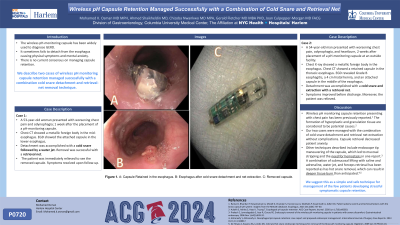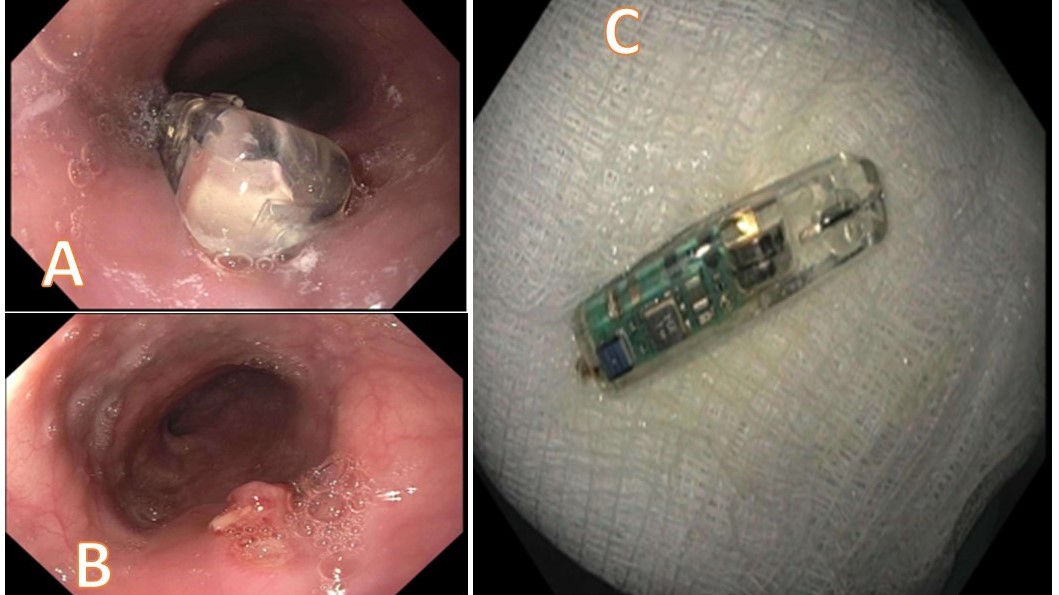Sunday Poster Session
Category: General Endoscopy
P0720 - Wireless pH Capsule Retention Managed Successfully With a Combination of Cold Snare and Retrieval Net
Sunday, October 27, 2024
3:30 PM - 7:00 PM ET
Location: Exhibit Hall E

Has Audio

Mohamed K. Osman, MD, MPH
NYC Health + Hospitals/Harlem
New York, NY
Presenting Author(s)
Mohamed K.. Osman, MD, MPH, Ahmed Shaikheldin, MD, Chizoba Nwankwo, MD, MPA, Gerald Fletcher, MD, MBA ,PHD, Joan Culpepper-Morgan, MD, FACG
NYC Health + Hospitals/Harlem, New York, NY
Introduction: The wireless pH-monitoring capsule has been widely used to diagnose GERD. It rarely fails to detach from the esophagus causing symptoms and there is no current consensus on managing capsule retention. We describe two cases of wireless pH monitoring capsule retention managed successfully with a combination cold snare detachment and retrieval-net removal technique.
Case Description/Methods: Case 1: A 53-year-old woman presented with worsening chest pain and odynophagia; 1 week after the placement of a pH-monitoring capsule. Chest CT showed a metallic foreign body in the mid-esophagus. EGD showed the attached capsule in the lower esophagus. Detachment was accomplished with a cold snare followed by a water jet. Removal was successful with a retrieval net. The patient was immediately relieved to see the removed capsule. Symptoms resolved upon follow-up.
Case 2: A 54-year-old man presented with worsening chest pain, odynophagia, and heartburn, 2 weeks after placement of a pH-monitoring capsule at an outside facility. Chest X-ray showed a metallic foreign body in the esophagus. Chest CT showed a retained capsule in the thoracic esophagus. EGD revealed Grade B esophagitis, a 4 cm hiatal hernia, and an attached capsule in the middle of the esophagus. Detachment was accomplished with a cold snare and extraction with a retrieval net. Symptoms improved before discharge. Moreover, the patient was relieved.
Discussion: Wireless pH monitoring capsule retention presenting with chest pain has been previously reported. The formation of hyperplastic and granulation tissue are considered to be potential causes. Our two cases were managed with the combination of cold snare detachment and retrieval net extraction without complications. Capsule retrieval decreased patient anxiety. Other techniques described include endoscope tip maneuvering of the capsule, which led to mucosal stripping and the need for hemostasis in one report. A combination of submucosal lifting with saline and adrenaline, water jet, and forceps retrieval has been reported as has hot snare removal, which can always result in deeper tissue burn than anticipated. We suggest this as a simple and safe technique for management for the few patients developing stressful symptomatic capsule retention.

Disclosures:
Mohamed K.. Osman, MD, MPH, Ahmed Shaikheldin, MD, Chizoba Nwankwo, MD, MPA, Gerald Fletcher, MD, MBA ,PHD, Joan Culpepper-Morgan, MD, FACG. P0720 - Wireless pH Capsule Retention Managed Successfully With a Combination of Cold Snare and Retrieval Net, ACG 2024 Annual Scientific Meeting Abstracts. Philadelphia, PA: American College of Gastroenterology.
NYC Health + Hospitals/Harlem, New York, NY
Introduction: The wireless pH-monitoring capsule has been widely used to diagnose GERD. It rarely fails to detach from the esophagus causing symptoms and there is no current consensus on managing capsule retention. We describe two cases of wireless pH monitoring capsule retention managed successfully with a combination cold snare detachment and retrieval-net removal technique.
Case Description/Methods: Case 1: A 53-year-old woman presented with worsening chest pain and odynophagia; 1 week after the placement of a pH-monitoring capsule. Chest CT showed a metallic foreign body in the mid-esophagus. EGD showed the attached capsule in the lower esophagus. Detachment was accomplished with a cold snare followed by a water jet. Removal was successful with a retrieval net. The patient was immediately relieved to see the removed capsule. Symptoms resolved upon follow-up.
Case 2: A 54-year-old man presented with worsening chest pain, odynophagia, and heartburn, 2 weeks after placement of a pH-monitoring capsule at an outside facility. Chest X-ray showed a metallic foreign body in the esophagus. Chest CT showed a retained capsule in the thoracic esophagus. EGD revealed Grade B esophagitis, a 4 cm hiatal hernia, and an attached capsule in the middle of the esophagus. Detachment was accomplished with a cold snare and extraction with a retrieval net. Symptoms improved before discharge. Moreover, the patient was relieved.
Discussion: Wireless pH monitoring capsule retention presenting with chest pain has been previously reported. The formation of hyperplastic and granulation tissue are considered to be potential causes. Our two cases were managed with the combination of cold snare detachment and retrieval net extraction without complications. Capsule retrieval decreased patient anxiety. Other techniques described include endoscope tip maneuvering of the capsule, which led to mucosal stripping and the need for hemostasis in one report. A combination of submucosal lifting with saline and adrenaline, water jet, and forceps retrieval has been reported as has hot snare removal, which can always result in deeper tissue burn than anticipated. We suggest this as a simple and safe technique for management for the few patients developing stressful symptomatic capsule retention.

Figure: A: Capsule Retained in the esophagus. B: Esophagus after cold snare detachment and net extraction. C: Removed capsule.
Disclosures:
Mohamed Osman indicated no relevant financial relationships.
Ahmed Shaikheldin indicated no relevant financial relationships.
Chizoba Nwankwo indicated no relevant financial relationships.
Gerald Fletcher indicated no relevant financial relationships.
Joan Culpepper-Morgan indicated no relevant financial relationships.
Mohamed K.. Osman, MD, MPH, Ahmed Shaikheldin, MD, Chizoba Nwankwo, MD, MPA, Gerald Fletcher, MD, MBA ,PHD, Joan Culpepper-Morgan, MD, FACG. P0720 - Wireless pH Capsule Retention Managed Successfully With a Combination of Cold Snare and Retrieval Net, ACG 2024 Annual Scientific Meeting Abstracts. Philadelphia, PA: American College of Gastroenterology.
